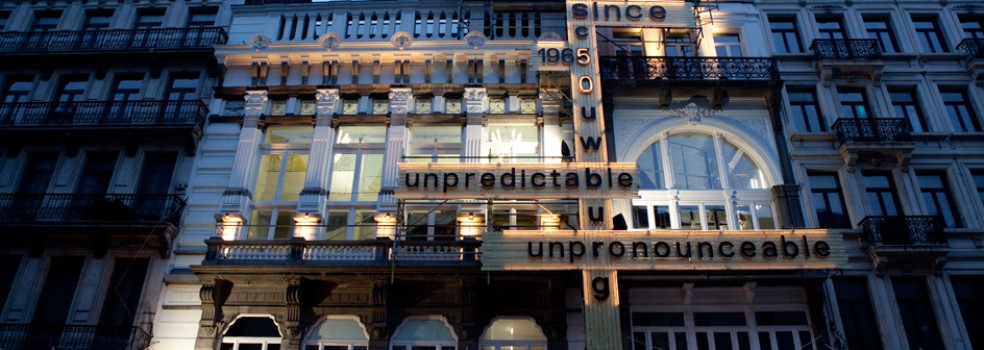There are places that simply by invoking their name call to mind the representation of what they stand for. As if we had always been accustomed to their existence. As if they had always embodied what we believed them to be. As if they were destined to perpetually populate the landscape with their silhouette. The Beursschouwburg would be part of this toponymy. About Beursschouwburg – Beurs for short – there’s much to say about its functions, actions, impulses, entertainment. A cultural center in Brussels asserting its bilingualism, a protean urban-inspired platform, a creative home where art is a dish that is best served hot… The literature of cultural agendas abounds with pictorial formulas to sell us the place.
No one could seriously question the curious and eclectic approach that has guided its steps: an often audacious and sometimes risky programming. Over the years, Dirk Seghers has been both its inspired linchpin and its needy soul. But even before him, the doors of the Beurs bore resolute posters. U2 and Tom Waits each gave their first Belgian concerts there. In another register, I remember having attended, before a stunned audience, the meeting of Jim O’Rourke, Peter Rehberg and Christian Fennesz at the opening of ‘White Nights’ in May 1998 for what appeared to be one of the first laptop computer concerts. I remember an Annie Sprinkle residence during which she undertook the deconstruction of the artifacts of pornographic speech. I keep in my memory extracts from brilliant and stunning concerts.
In the early 2000s, the Beurs migrated Unlike other places, it doesn't seem to have lost its soul in the adventure of its transformation.
to rue de la Caserne, in order to proceed with its renovation. If the setting of BSB II was more rudimentary, the programming maintained its cadence. This is where we tasted, on an early fall evening, the soup concocted by Das Erste Wiener Gemüseorchester, a Viennese ensemble who used for its instruments only fresh vegetables worked with a knife which fell into in a huge pot, gradually, as the performance progressed. For my part, I had the chance to perform, as the opening act of Peter Vermeersch’s combo Flat Earth Society, a DJ set with two electric fryers, one to cook fries, the other reserved for fricadelles.
Despite the expensive work of embellishment, the Beurs remains what it has always been since its inception: a theater. To its famous staircase and reception area have been added a vast brasserie on the ground floor and a panoramic terrace which turns into an open air cinema in summer. The place has become more spacious and more compartmentalized even as it claims the street as a natural extension of its foundation. Unlike other places, it doesn’t seem to have lost its soul in the adventure of its transformation.
Curiously, the image that comes to mind when I think of Beursschouwburg is not a representation of the building or its interior. It focuses on a detail. A piece of brown stucco that formerly appeared in the main room. If the shape of the ornament has become blurred in my mind, I distinctly remember it was chipped. I associate its brown patina with a photograph. One that appears on the cover of the album ‘Before Hollywood’ by The Go-Betweens. Released in 1983, the record revealed to the European public the heretofore unknown Australian group. This cover had lain around my desk for months. The photo shows Robert Forster, Grant McLennan and Lindy Morrison who stand looking thoughtful in a quaint interior which it is impossible to say whether it is that of a room or the background of a junk shop.
When the group came to play on the rue Auguste Orts in October 1988, I took ‘Before Hollywood’ out of the closet. It made sense to me for The Go-Betweens to invest in a cozy old theater, and this was the natural place to listen to them. During the concert, I could not help but think back to the photo as my eyes fixed on the damaged walls of the room when I got tired of scrutinizing the musicians on stage. The association was forged in my imagination at that time. It was sealed definitively when, for the encore, McLennan and Forster came back to play ‘Cattle And Cane’. The two members told us an old story. One from the Australian plains of their birth. A child who passes through them to reach his house on the way home from school. Cattle in the sun, the cane fields. The memory of places that fades with time. But never quite. There remains something small. A substrate. A piece of chipped stucco.
Eric Therer
